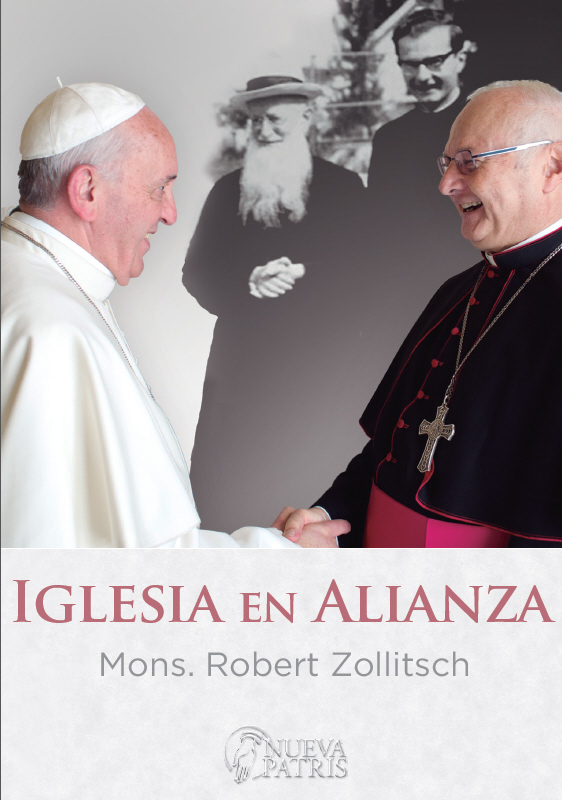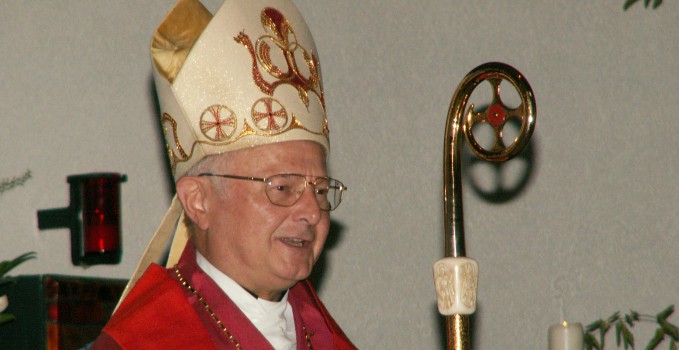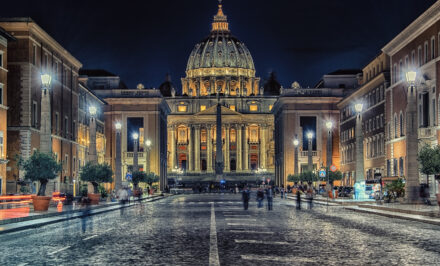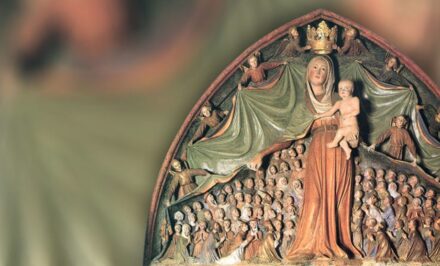Editors of schoenstatt.org •
Archbishop Emeritus Robert Zollitsch, during the Freiburg diocesan pilgrimage to Schoenstatt, gave a sermon to the pilgrims picking up central moments of Pope Francis` message to the Schoenstatt Movement at the jubilee pilgrimage to Rome, October 25, 2014.
We here publish the English translation of the text the text of the sermon as authorized by Archbishop Zollitsch
“Mary, my Mother, let me go with you!”
The pilgrims who went to Rome for the centenary celebrations of Schoenstatt’s foundation gladly recall the meeting with Pope Francis on 25 October last year. After we had all renewed the covenant of love, our Holy Father said, “In giving you the blessing, I send you out as missionaries into the years to come. … I send you, not alone, but hand in hand with our Mother Mary.”[1] Yesterday and today, a year later, we set out on our diocesan pilgrimage to Schoenstatt in order to answer our Holy Father and the Blessed Mother, “Mary, my Mother, let me go with you!”
I.
The hundred years of Schoenstatt’s richly blessed history, as well as our own encouraging experience of faith, give us the courage to take hold of the Blessed Mother’s outstretched hand and allow ourselves to be led by her. There is at the same time the encouragement of our Holy Father who never ceases pointing out that Mary our Mother is in the first place and above all our Mother.[2]
She not only gave birth to Jesus, she also helps us “so that Jesus can be born and grow in us. She is the one who continuously gives us life.”[3] That forms part of the supportive and fundamental conviction and living spirituality of Pope Francis. In his wonderful exhortation “The Joy of the Gospel” our Holy Father explained, “On the cross … at that crucial moment, before fully accomplishing the work which his Father had entrusted to him, Jesus said to Mary: ‘Woman, here is your son’. Then he said to his beloved friend: ‘Here is your mother!’ (Jn 19:26-27). … Jesus left us his mother to be our mother. Only after doing so did Jesus know that ‘all was now finished’ (Jn 19:28). At the foot of the cross, at the supreme hour of the new creation, Christ led us to Mary. He brought us to her because he did not want us to journey without a mother … Mary, who brought him into the world with great faith, also accompanies ‘the rest of her offspring, those who keep the commandments of God and bear testimony to Jesus’” (Rev 12:17).[4] Jesus gave us his mother to be our mother, “because he didn’t want us to be without a mother”, because he knew how much we need a mother, and what a great gift it is to have a mother, and to walk hand in hand with her as a child. So far Pope Francis.
Some object to being a child and to being led as adults by a mother’s hand, although there is in each one of us a bit of longing to be a child. According to the Gospel, being a child is a condition for entering the kingdom of heaven. The Gospel for this Sunday tells us this very clearly.
II.
At first glance it may surprise us, but on taking a second look it could even console us somewhat, to see that also Jesus’ disciples were very human. Jesus was disappointed that they did not concern themselves with what he had just announced to them – his death and resurrection. Instead they were fighting about who was the greatest among them.
Jesus gave them and us a clear and at the same time human answer; it is an answer in an image that appeals to all of us and that all can understand. He placed a child in their midst. They should welcome that child and in that child welcome Jesus. They should accept that child – both as an image and example – take their bearings from it and learn from it. For, as Jesus said almost provocatively to them and us, “Unless you become like little children, you cannot enter the kingdom of heaven” (Mt 18:3).
With regard to the child and being a child in the sense Jesus intended, we are not dealing with a romantic idealisation of a naïve and innocent existence. No, what we are dealing with here is the openness and ability to be surprised and gifted; we are dealing with unlimited trust and the readiness to be led; with the readiness to take hold of a loving and supportive hand, a guiding and sheltering hand, that reaches out to us, and allow ourselves to be helped and guided on our way. “The kingdom of heaven belongs” (Lk 13:14) to people who open themselves to the Gospel with this attitude, and who look for God with this attitude. That is Jesus’ promise.
III.
So the question of our “childhood before God”, the question of “being a child of God”, of a “childlike attitude to God and the Blessed Mother”, was one of the biggest, even a favourite subject of Schoenstatt’s founder, Fr Joseph Kentenich. For him Christian perfection, holiness, consists in the perfect attitude of a child towards God.[5] “In order that we learn it, God has given us his Mother.”[6]
Thus Fr Kentenich is completely at one with Pope Francis who told us that we need a mother who educates us, who lets us grow, who accompanies us and leads us to Jesus.[7] He challenged us, “Let us make room for Mary, the Mother.”[8]
It is the great gift of the Blessed Mother here in Schoenstatt – a way that has proved its value in many and varied ways for a hundred years: Mary reaches out towards us, she invites us to take her hand in order to enter into a covenant, a covenant of love with her. She offers to accompany us on our way; she invites us to share in her love for Jesus, and to allow her to lead us to her Son. She stands before us as the great example and committed accompanier: as the believer who followed her Son; as the loving and caring Mother who suffers with her Son and with us, and shares all our pain. She is the Mother who understands, as Pope Francis put it, how “to transform a stable into a home for Jesus with a few rags and a mountain of tenderness”.[9]
She, who “received us as children when a sword pierced her soul”,[10] is close to us in all our needs, she understands our worries and shares our pain.
She is close to us and is there for us – that is the experience of many saints and all those who are led by her hand as they walk the pilgrim path of faith in the covenant of love. She is there even when we are sometimes headstrong and want to go our own way. The hymn by Johannes Ganz, from which the motto for this year’s diocesan pilgrimage has been taken, expresses this experience. Mary is active; she comes towards us, she addresses us, she calls us by name. She isn’t loud; she doesn’t overpower us, she doesn’t force herself upon us. She speaks to us quietly in the language of the heart, with the language of love and invitation. She takes us by the hand, because she is our Mother, and also wants to be our Mother. She knows how often we are stubborn and wilful, yet she doesn’t withdraw. On the contrary, she lifts us up if we have fallen. She is Mother.
IV.
The motto of our diocesan pilgrimage this year invites us to allow Mary to take us by the hand and lead us – not only here to her shrine in Schoenstatt. Not only yesterday and today to pray at a place of grace and with her to encounter her Son Jesus Christ; no, she invites us, she pleads with us, to entrust ourselves to her, to allow ourselves to be led by her, and to allow her to increasingly form and educate us according to her image into believing, hoping and loving people; to allow ourselves to be infected by her love for her Son: indeed, with her help to allow Jesus Christ to be formed in us more and more.
This was the way and is the attractive example of Schoenstatt’s founder, Fr Joseph Kentenich. When he looked back on his life as he celebrated the Silver Jubilee of his ordination to the priesthood, he confessed, “She (the Blessed Mother) has personally formed and moulded me from my ninth year onwards”,[11] from the moment his mother entrusted him to Mary.[12] He gratefully acknowledged that his education “was the work of the Blessed Mother”.[13]
We set out as pilgrims to go to the shrine of the Blessed Mother here in Schoenstatt. Most of you, dear pilgrims from the Archdiocese of Freiburg, have done it year after year. Behind it isn’t there the gratifying experience that we feel that Mary no only attracts us to herself, but also carries, protects and supports us in our lives? This experience is confirmed by Pope Francis when he states, “There, in these many shrines, we can see how Mary brings together her children who with great effort come as pilgrims to see her and to be seen by her. Here they find the strength from God to bear the weariness and the suffering in their lives” (EG 286).
We may be grateful to our Holy Father Pope Francis for encouraging us and allowing us to share in his love for the Blessed Mother. He is obviously sharing his experience and conviction with his predecessor, Pope St Pius X, for whom it was obvious “that there is no surer and more direct road than by Mary, for uniting all mankind in Christ and obtaining through Him the perfect adoption of sons, that we may be holy and immaculate in the sight of God.”[14] Pope Francis confessed as his secret that every morning when he gets up he touches the picture of the Blessed Mother, the Pilgrim Mother, on his beside table, and prays.[15] He now sends us out “hand in hand with our Mother Mary”.[16] He encourages us and tells each of us that the Blessed Mother says to us what she whispered to St Juan Diego when she appeared to him at Guadalupe, “Do not let your heart be troubled. … Am I not here, who am your Mother?” (EG 286) Yes, she is here. This is what we confess in the last verse of the hymn by Johannes Ganz: “You show us Christ and you lead us to him, my life gains meaning through you. With him in my heart and my hand in yours, my path leads home to the Father.”
[1] A Culture of Encounter, p. 49 (Nueva Patris, Chile 2015)
[2] ibid, p. 21.
[3] ibid, p. 22.
[4] Evangelii Gaudium, Nr. 285.
[5] Cf. Joseph Kentenich, Marianische Erziehung (Marian Education), Vallendar 1971, p. 172 ff.
[6] ibid, p. 173.
[7] Cf. A Culture of Encounter, p.21 ff.
[8] Pope Francis, Address 6 July 2015, Guayaquil.
[9] Culture of Encounter, p. 21.
[10] Pope Francis, Address in Guayaquil.
[11] Fr J. Kentenich, Address at the Celebration of his Silver Jubilee of Ordination on 11 August 1935, in: P. Locher et al (ed): Kentenich Reader I, Vallendar, p. 65.
[12] F. Kastner, Unter dem Schutze Mariens, Vallendar-Schoenstatt 4, 1952, p. 184.
[13] Kentenich Reader I, p. 65.
[14] Papal Teachings – Our Lady, St Paul Editions, 1961, p.168.
[15] A Culture of Encounter, p. 49f.
[16] ibid, p.49
 The book quoted several times by Archbishop em. Zollitsch, “A Culture of Encounter”, Pope Francis` message to the Schoenstatt Movement on October 25, 2014, with a prologue by Fr. José María García Sepúlveda, Madrid, and edited by Nueva Patris, Chile, in cooperation with schoenstatt.org, is available HERE, at the Schoenstatt Shrine in Bolton, England; House Marienau, Schoenstatt, and the Schoenstatt Center in Memhölz, Germany.
The book quoted several times by Archbishop em. Zollitsch, “A Culture of Encounter”, Pope Francis` message to the Schoenstatt Movement on October 25, 2014, with a prologue by Fr. José María García Sepúlveda, Madrid, and edited by Nueva Patris, Chile, in cooperation with schoenstatt.org, is available HERE, at the Schoenstatt Shrine in Bolton, England; House Marienau, Schoenstatt, and the Schoenstatt Center in Memhölz, Germany.
You can order it in each bookstore providing the ISBN: 978-956-246-775-9
Also as E-Book (Amazon Kindle, Android, iBook…).
Other languages: www.patris.cl
 Another book will soon be published in the same publishing house: Church as Covenant, with two conferences by Archbishop em. Robert Zollitsch, on the charism of Father Kentenich an the Church that is setting out, in the light of the pontificate of Pope Francis (in German, Spanish, English, Italian, Portguese).
Another book will soon be published in the same publishing house: Church as Covenant, with two conferences by Archbishop em. Robert Zollitsch, on the charism of Father Kentenich an the Church that is setting out, in the light of the pontificate of Pope Francis (in German, Spanish, English, Italian, Portguese).














